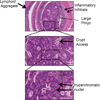AOM/DSS Model of Colitis-Associated Cancer
- PMID: 27246042
- PMCID: PMC5035391
- DOI: 10.1007/978-1-4939-3603-8_26
AOM/DSS Model of Colitis-Associated Cancer
Abstract
Our understanding of colitis-associated carcinoma (CAC) has benefited substantially from mouse models that faithfully recapitulate human CAC. Chemical models, in particular, have enabled fast and efficient analysis of genetic and environmental modulators of CAC without the added requirement of time-intensive genetic crossings. Here we describe the Azoxymethane (AOM)/Dextran Sodium Sulfate (DSS) mouse model of inflammatory colorectal cancer.
Keywords: AOM; Colitis-associated cancer; Colon cancer; DSS; Inflammatory carcinogenesis.
Figures





References
-
- Siegel R, Ma J, Jemal A. Cancer statistics, 2014. CA. Cancer J Clin. 2014;64:9–29. - PubMed
-
- Danese S, Malesci A, Vetrano S. Colitis-associated cancer: the dark side of inflammatory bowel disease. Gut. 2011;60:1609–1610. - PubMed
-
- Danese S an, Mantovani A. Inflammatory bowel disease and intestinal cancer : a paradigm of the Yin – Yang interplay between inflammation and cancer. Oncogene. 2010;29:3313–3323. - PubMed
-
- Terzić J, Grivennikov S, Karin E, Karin M. Inflammation and colon cancer. Gastroenterology. 2010;138:2101–2114. - PubMed
Publication types
MeSH terms
Substances
Grants and funding
LinkOut - more resources
Full Text Sources
Other Literature Sources
Medical

